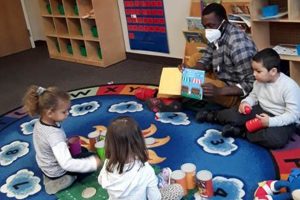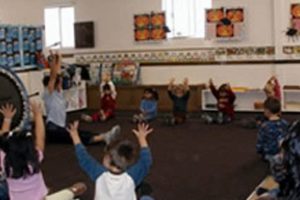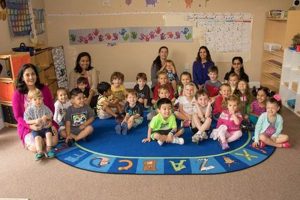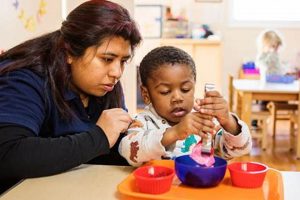Educational materials designed for early childhood learning environments employing the Montessori Method often take the form of specially crafted print resources. These resources emphasize hands-on engagement, self-directed learning, and sensory exploration. Examples include tactile number boards, sandpaper letters, and classified picture cards. These materials are typically designed with natural materials and aim to isolate specific concepts, allowing children to internalize information through repeated interaction.
These specialized resources play a crucial role in fostering cognitive development, fine motor skills, and pre-literacy skills. The emphasis on self-paced learning allows children to explore concepts at their own speed, building confidence and intrinsic motivation. Historically, these educational tools emerged from Maria Montessori’s observations of children’s natural learning processes, emphasizing the importance of concrete, sensory experiences in early childhood development. These resources aim to prepare a foundation for future academic pursuits by fostering a love of learning and exploration.
This foundation provides a springboard for deeper exploration of various related topics, such as curriculum development, classroom implementation strategies, and the selection of appropriate materials for different age groups within the Montessori framework.
Tips for Utilizing Montessori-Aligned Learning Materials
Effective implementation of Montessori principles requires careful consideration of the learning materials. The following tips offer guidance on maximizing their educational potential.
Tip 1: Observe the Child: Careful observation of a child’s interests and developmental stage is crucial. Materials should align with current abilities and provide an appropriate level of challenge.
Tip 2: Prioritize Hands-On Engagement: Materials should encourage active manipulation and exploration. Tactile experiences are essential for internalizing concepts.
Tip 3: Maintain Order and Accessibility: A well-organized and accessible environment allows children to independently select and return materials, fostering self-reliance.
Tip 4: Introduce Materials Purposefully: Each material should be presented with clear, concise instructions, demonstrating its proper use and purpose.
Tip 5: Allow for Repetition: Repetition is key to mastery. Children should be encouraged to engage with materials multiple times, reinforcing learning through practice.
Tip 6: Foster Independence: Create an environment where children can explore and learn independently. Avoid interrupting focused work unless necessary.
Tip 7: Integrate Materials Across Curriculum: Connect concepts across different subject areas. For example, math materials can be integrated into practical life activities.
By implementing these tips, one can create a rich and engaging learning environment that supports children’s natural curiosity and fosters a lifelong love of learning.
These practical strategies provide a framework for maximizing the effectiveness of Montessori-aligned educational resources, leading to a deeper understanding of the principles and practices within a Montessori learning environment.
1. Sensory Engagement
Sensory engagement forms a cornerstone of Montessori education, particularly within the context of early literacy development. Montessori preschool materials, including books, are intentionally designed to stimulate multiple senses. Tactile elements, such as textured pages, raised lettering, or movable parts, allow children to physically interact with the story. Visual stimulation is achieved through vibrant illustrations, clear fonts, and uncluttered layouts. Auditory learning is incorporated through rhyming texts, sound books, or storytelling activities. This multi-sensory approach strengthens neural connections and facilitates deeper comprehension. For example, a book about different textures might include swatches of corduroy, silk, or burlap, allowing children to connect the word with the tangible sensation. This experiential learning fosters a stronger connection between language and the real world.
The emphasis on sensory engagement caters to the developmental needs of preschoolers. At this age, children primarily learn through their senses, exploring the world through touch, sight, and sound. Multi-sensory books provide a bridge between concrete experiences and abstract concepts, making learning more engaging and accessible. Furthermore, sensory engagement can help children focus their attention and regulate their sensory input, crucial for early learning and development. A child struggling with sensory overload, for example, might find solace in a quiet book with tactile elements, providing a calming and focused activity.
Integrating sensory experiences into early literacy practices lays a strong foundation for future learning. By engaging multiple senses, children develop a deeper understanding of language, enhance their cognitive skills, and cultivate a love of reading. The careful selection and implementation of sensory-rich books within a Montessori preschool environment can significantly impact a child’s literacy journey and overall development. This approach acknowledges the crucial role sensory exploration plays in early childhood, ensuring learning becomes a holistic and engaging experience.
2. Hands-on Learning
Hands-on learning is a cornerstone of the Montessori educational approach, particularly within the context of preschool literacy. It emphasizes active engagement with materials, allowing children to explore concepts through tactile and kinesthetic experiences. This approach fosters a deeper understanding of abstract concepts by connecting them to concrete actions. Within the realm of Montessori preschool books, this translates to interactive elements that encourage manipulation and exploration, moving beyond passive observation.
- Manipulative Elements:
Montessori-aligned books often incorporate manipulative elements such as movable parts, flaps, or textures. These features allow children to physically interact with the story, reinforcing comprehension and engagement. For instance, a book about counting might include beads or buttons that children can move as they count along. This tactile interaction solidifies number concepts and provides a concrete representation of abstract numerical values.
- Book-Related Activities:
Hands-on learning extends beyond the book itself. Activities related to the story, such as puppet shows, retelling with props, or creating artwork based on the narrative, provide further opportunities for active engagement. These extensions deepen understanding and encourage creativity. Building a diorama based on a story setting, for example, allows children to visualize and interact with the narrative in a tangible way.
- Writing and Drawing:
Integrating writing and drawing activities alongside reading fosters a holistic approach to literacy. Children can create their own stories, illustrate scenes from a book, or practice writing letters and words related to the narrative. This hands-on approach connects reading and writing, developing fine motor skills and encouraging self-expression. Copying words from a favorite book, for example, reinforces letter recognition and strengthens hand-eye coordination.
- Practical Life Skills:
Many Montessori preschool books connect literacy with practical life skills. Books about cooking, gardening, or caring for pets can be paired with real-life activities. This integration makes learning relevant and meaningful. Reading a book about planting seeds, followed by planting seeds in a classroom garden, provides a concrete and engaging learning experience, connecting abstract concepts to real-world applications.
By incorporating these hands-on elements, Montessori preschool books facilitate a deeper understanding of literacy concepts, fostering a love of reading and learning. This active engagement lays a strong foundation for future academic success and encourages a lifelong appreciation for books and the knowledge they contain. The connection between hands-on learning and Montessori-aligned books transforms reading from a passive activity to an interactive and enriching experience.
3. Self-Directed Exploration
Self-directed exploration forms a core tenet of Montessori education, deeply intertwined with the utilization of learning materials, including books. This pedagogical approach emphasizes the child’s innate curiosity and drive to learn, empowering them to choose activities and pursue knowledge independently. Within a Montessori preschool environment, specifically designed books and materials facilitate self-directed exploration by offering accessible, engaging resources that cater to individual interests and developmental stages. This approach fosters intrinsic motivation, cultivates a love of learning, and develops essential skills such as problem-solving, critical thinking, and concentration. For instance, a child fascinated by dinosaurs might independently select a book about paleontology, sparking further exploration through related activities like drawing dinosaur skeletons or creating a prehistoric landscape. This self-initiated learning journey, guided by the child’s inherent curiosity, fosters a deeper and more meaningful understanding than traditional didactic instruction.
The availability of diverse, age-appropriate books within a prepared environment plays a crucial role in nurturing self-directed exploration. Organized shelves with clearly labeled materials allow children to browse, select, and return resources independently, fostering a sense of autonomy and responsibility. The books themselves often incorporate features that promote self-discovery, such as interactive elements, clear illustrations, and concise text. These features empower children to engage with the material at their own pace, revisit concepts as needed, and draw their own conclusions. A child exploring a book about fractions, for example, might utilize accompanying manipulatives to visualize and internalize the concept, progressing at their own speed and building confidence through self-discovery. This individualized learning experience caters to diverse learning styles and fosters a sense of ownership over the learning process.
Cultivating self-directed exploration through carefully curated learning materials, including books, contributes significantly to a child’s holistic development. This approach nurtures not only cognitive growth but also essential social-emotional skills like self-regulation, persistence, and independence. While challenges may arise in guiding children towards appropriate choices and maintaining a balance between structured activities and free exploration, the benefits of fostering self-directed learning within a Montessori preschool environment are substantial. By providing access to engaging, accessible, and developmentally appropriate books, educators empower children to become active participants in their own learning journey, laying the foundation for lifelong curiosity and a genuine love of knowledge. This emphasis on self-directed exploration aligns with the broader Montessori philosophy of fostering independence and empowering children to become self-sufficient learners.
4. Real-life Connections
Montessori education emphasizes the importance of connecting learning to real-life experiences. This principle is deeply embedded in the selection and utilization of learning materials, including books, within Montessori preschool environments. Connecting learning to tangible, everyday experiences makes abstract concepts more accessible and meaningful for young children. This approach fosters a deeper understanding of the world and encourages practical application of learned skills.
- Practical Life Skills:
Many Montessori preschool books focus on practical life skills, such as dressing, cooking, gardening, or caring for pets. These books provide children with opportunities to learn about activities they encounter in their daily lives. A book about preparing a simple snack, for example, can be linked to a real-life activity where children prepare the snack themselves. This connection reinforces learning and empowers children to participate actively in their daily routines.
- Cultural Representation:
Books featuring diverse characters, cultures, and traditions expose children to a broader understanding of the world around them. These real-life connections foster inclusivity and empathy. Reading a book about a child celebrating a different cultural holiday, for example, can spark discussions about different traditions and promote respect for diversity.
- Nature and Science:
Books about nature and science can be connected to real-world explorations. A book about the life cycle of a butterfly, for instance, can be complemented by observing butterflies in a garden or raising caterpillars in the classroom. These real-life connections transform abstract concepts into tangible experiences, fostering a deeper understanding of scientific principles.
- Community and Social Interactions:
Books about community helpers, social interactions, and emotions provide children with insights into social dynamics and community life. Reading a book about visiting the doctor, for example, can be linked to a role-playing activity or a visit from a local healthcare professional. These real-life connections help children understand their roles within the community and develop essential social skills.
By emphasizing real-life connections, Montessori preschool books foster a deeper understanding of the world and encourage children to apply their knowledge in practical ways. This approach makes learning more relevant, engaging, and meaningful, contributing to a holistic educational experience that prepares children for life beyond the classroom. The integration of real-life experiences into the curriculum through carefully chosen books exemplifies the Montessori philosophy of connecting learning to the child’s lived reality.
5. Concrete Materials
Concrete materials are fundamental to the Montessori approach, serving as essential tools for learning within preschool settings. These tangible resources provide a bridge between abstract concepts and concrete experiences, enabling young children to grasp complex ideas through hands-on manipulation and exploration. Within the context of Montessori preschool books, concrete materials often accompany and complement the text, enriching the learning experience and deepening comprehension. For instance, a book about geometric shapes might be paired with corresponding wooden blocks, allowing children to physically manipulate the shapes, compare their properties, and internalize their characteristics. This tactile and kinesthetic interaction solidifies understanding in a way that simply reading about shapes cannot achieve. Similarly, a book about counting could be accompanied by a set of counters, enabling children to physically represent numerical values and perform basic arithmetic operations. This concrete representation of abstract mathematical concepts lays a strong foundation for future mathematical learning.
The use of concrete materials alongside Montessori preschool books has several significant benefits. It caters to the developmental needs of young children, who primarily learn through sensory exploration and hands-on experiences. Concrete materials provide a tangible link to abstract concepts, making learning more engaging and accessible. Furthermore, manipulating these materials promotes the development of fine motor skills, hand-eye coordination, and spatial reasoning. For example, a child using a set of textured letters to trace and identify letterforms develops fine motor control while simultaneously internalizing letter recognition skills. Additionally, the use of concrete materials fosters independence and self-directed learning. Children can explore concepts at their own pace, repeating activities as needed and discovering relationships between concepts independently. This self-directed exploration builds confidence and intrinsic motivation, essential for lifelong learning.
In summary, the integration of concrete materials with Montessori preschool books represents a cornerstone of effective Montessori pedagogy. This approach provides a multi-sensory, hands-on learning experience that fosters deep understanding, promotes skill development, and cultivates a love of learning. While challenges may exist in acquiring and organizing these materials, the educational benefits they provide are substantial, contributing significantly to a child’s holistic development. The purposeful selection and utilization of concrete materials alongside books ensures that learning becomes a tangible and meaningful experience, laying a solid foundation for future academic success. This connection between concrete materials and Montessori preschool books highlights the emphasis on experiential learning within the Montessori philosophy.
6. Isolating Concepts
Isolating concepts is a core principle within the Montessori method, particularly relevant to the design and utilization of preschool books. This approach involves presenting individual concepts in a clear, focused manner, minimizing distractions and allowing children to grasp each concept thoroughly before moving on to more complex ideas. This methodical presentation fosters deep understanding and facilitates the internalization of knowledge.
- Distinct Presentation:
Montessori preschool books often present a single concept per page or spread. This clear delineation avoids overwhelming children with multiple stimuli, allowing them to focus their attention on one specific element at a time. For instance, a book about colors might dedicate one page solely to the color red, showcasing various objects of that color without introducing other hues. This isolated presentation reinforces color recognition and avoids confusion that might arise from presenting multiple colors simultaneously.
- Gradual Introduction of Complexity:
Concepts are introduced sequentially, progressing from simple to complex. This gradual progression ensures that children build a solid foundation before tackling more challenging ideas. For example, a book about numbers might begin with the number one, introducing subsequent numbers one at a time. This measured introduction allows children to master each number concept before moving on to more complex numerical relationships.
- Concrete Representation:
Abstract concepts are often represented through concrete examples and illustrations. This tangible representation makes abstract ideas more accessible and understandable for young children. A book about emotions, for example, might depict a child expressing a specific emotion through facial expressions and body language, providing a concrete visual representation of an abstract concept.
- Repetition and Practice:
Opportunities for repetition and practice are embedded within Montessori materials and activities, including books. This repeated exposure reinforces learning and allows children to internalize concepts through repeated interaction. For example, a book about letter sounds might encourage children to trace letterforms or repeat the associated sound, reinforcing the connection between the visual symbol and the auditory representation through repeated practice.
The principle of isolating concepts, as implemented within Montessori preschool books, contributes significantly to a child’s cognitive development. By presenting concepts in a clear, focused, and sequential manner, these resources foster a deep understanding of fundamental concepts, preparing children for more complex learning experiences as they progress through their educational journey. This meticulous approach to concept introduction distinguishes Montessori pedagogy and underscores the importance of focused learning in early childhood education.
7. Developmental Appropriateness
Developmental appropriateness is a cornerstone of Montessori education, inextricably linked to the selection and utilization of learning materials, including books, within preschool settings. This principle emphasizes aligning learning experiences with children’s developmental stages, considering their cognitive, physical, social, and emotional capacities. Developmentally appropriate Montessori preschool books cater to children’s evolving abilities, providing engaging and challenging experiences that foster growth without causing frustration or discouragement. This careful alignment ensures that learning materials effectively support children’s progress and nurture their intrinsic motivation to learn. For example, a book designed for a three-year-old might feature simple vocabulary, large print, and tactile elements, whereas a book for a five-year-old could incorporate more complex sentence structures, detailed illustrations, and opportunities for problem-solving. Matching book content and format to a child’s developmental stage ensures an optimal learning experience and fosters a sense of accomplishment.
The practical implications of prioritizing developmental appropriateness are substantial. Choosing books that align with children’s current abilities fosters engagement and encourages active participation. Books that are too challenging can lead to frustration and discouragement, while books that are too simple can fail to stimulate intellectual curiosity. Developmentally appropriate books provide an optimal balance of challenge and support, allowing children to experience success and build confidence in their learning abilities. Furthermore, these books often incorporate elements that cater to specific developmental milestones, such as developing fine motor skills through interactive elements or fostering language acquisition through repetitive phrases and rich vocabulary. A book with lift-the-flaps, for example, supports fine motor development in younger children, while a book with complex narratives fosters language comprehension and critical thinking in older preschoolers. This targeted approach ensures that learning materials effectively support children’s progress across various developmental domains.
Careful consideration of developmental appropriateness is essential for maximizing the effectiveness of Montessori preschool books. Educators and caregivers must observe children’s individual progress, interests, and learning styles to select books that provide an optimal challenge and foster a love of reading. While adhering strictly to age-based recommendations can be limiting, understanding developmental milestones and recognizing individual variations within a given age group are crucial for providing a truly individualized and effective learning experience. This nuanced approach, combined with a rich and diverse selection of developmentally appropriate books, creates a literacy-rich environment that supports children’s holistic development and nurtures their lifelong love of learning. This focus on developmental appropriateness aligns with the broader Montessori philosophy of respecting the individual child and fostering their unique potential.
Frequently Asked Questions
This section addresses common inquiries regarding learning materials designed for Montessori preschool environments.
Question 1: How do these specialized resources differ from traditional preschool books?
These materials prioritize hands-on engagement, self-directed learning, and sensory exploration, often incorporating manipulative elements and concrete objects. Traditional preschool books may focus primarily on visual and auditory learning.
Question 2: What are the key characteristics to look for when selecting these specific learning tools?
Key characteristics include materials crafted from natural elements, isolation of specific concepts, activities promoting self-discovery, and alignment with developmental milestones.
Question 3: Are these specific educational tools only beneficial for children enrolled in Montessori programs?
While designed for Montessori classrooms, the underlying principles of hands-on learning, sensory engagement, and self-directed exploration can benefit all preschool-aged children. Adapting these principles and selecting appropriate resources can enhance learning in various educational settings.
Question 4: How can one effectively incorporate these specific educational materials into a home learning environment?
Creating a prepared environment at home, with organized shelves and accessible materials, allows for self-directed exploration. Following the child’s interests, providing concise introductions, and allowing for repetition can effectively integrate these principles into home learning. Supplementing with related hands-on activities further enhances the learning experience.
Question 5: What are some common misconceptions surrounding these specific educational resources?
A common misconception is that these specific resources are overly simplistic or lack academic rigor. However, these meticulously designed tools build a strong foundation for future learning by fostering deep understanding, critical thinking, and a love of learning through concrete, sensory experiences. They provide a crucial bridge to abstract concepts encountered later in academic pursuits.
Question 6: Where can one find high-quality examples of these specialized learning tools?
Specialized Montessori educational supply stores, reputable online retailers, and some educational publishers offer high-quality examples of these specific learning tools. Evaluating materials based on adherence to Montessori principles, material quality, and developmental appropriateness ensures effective selection.
Careful consideration of these points clarifies the value and purpose of Montessori-aligned learning materials within preschool education. Understanding these principles facilitates effective implementation and maximizes learning outcomes.
Further exploration of specific material categories and their practical application within a Montessori learning environment can deepen understanding and inform practical implementation strategies.
Conclusion
Exploration of resources tailored for Montessori preschool environments reveals their distinctive characteristics and pedagogical value. Emphasis on sensory engagement, hands-on learning, self-directed exploration, real-life connections, concrete materials, concept isolation, and developmental appropriateness collectively contribute to a unique learning experience. These elements foster deep understanding, critical thinking skills, and a lifelong love of learning. Furthermore, these specialized learning tools establish a solid foundation for future academic pursuits by nurturing intrinsic motivation and building confidence in one’s learning abilities. The careful selection and implementation of these resources within a prepared environment are crucial for maximizing their educational impact.
The significance of these specialized learning tools lies in their potential to transform early childhood education. By aligning with children’s natural learning processes and fostering a joy of discovery, these resources empower children to become active participants in their educational journey. Continued research and development of innovative materials promise further advancements in early childhood education, building upon the foundational principles established by Maria Montessori. Embracing these principles and investing in high-quality learning materials contributes significantly to cultivating a future generation of engaged, confident, and capable learners. The potential of these specialized educational resources to shape future generations underscores the importance of their thoughtful application within early childhood learning environments.







